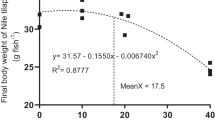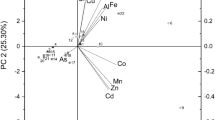Abstract
An algal astaxanthin feeding trial was carried out to investigate the effects of natural astaxanthin from Haematococcus pluvialis as feed additives on growth, pigmenting efficacy and antioxidant capacity in blood parrot ( Cichlasoma citrinellum × Cichlasoma. synspilum ). Tissue total antioxidant capacity (TAC), superoxide dismutase (SOD), catalase (CAT) and maleic dialdehyde (MDA) were chosen as measures of its antioxidant capacity. All fish which received an astaxanthin (from micro-algal H. pluvialis ) supplemented diet with 400 mg/kg of astaxanthin, after 50 days of feeding, the astaxanthin-fed fish displayed a pinkcolored skin and the control-fed fish displayed a grayish skin. For the growth, the weight gains of controlfed fish and astaxanthin-fed fish were 200% and 300%, respectively. Samples of skin and scales were used for analysis of total carotenoids and astaxanthin content, and fish feeding astaxanthin showed significantly ( P <0.05) higher concentrations than the control group, indicating that the pigmentation of this fish had been significantly improved by dietary astaxanthin. Compared with the control fish, pigmented fish had lower SOD, CAT and MDA and higher TAC. It can be concluded that supplementation with dietary astaxanthin could effectively enhance growth, skin coloration and the antioxidant capacity of this fish. This study will provide a reference for application of natural astaxanthin from H. pluvialis as feed additives in blood parrot artificial breeding. Our data is also useful in ornamental fish farming, especially when the retentivity of astaxanthin in the skin and scales are involved. It is leading to the possibility of increasing the pigmentation of farmed-fish by adding the powdered form of H. pluvialis to the diet as an effective pigment.
Similar content being viewed by others
References
Andersen F, Lygren B, Maage A, Waagbø R. 1998. Interaction between two dietary levels of iron and two forms of ascorbic acid and the effect on growth, antioxidant status and some non–specific immune parameters in Atlantic salmon( Salmo salar ) smolts. Aquaculture, 161(1–4): 437–451.
Arredondo–Figueroa J L, Pedroza–Islas R, Ponce–Palafox J T, Vernon–Carter E J. 2003. Pigmentation of pacific white shrimp( Litopenaeus vannamei, Boone 1931) with esterified and saponified carotenoids from red chili ( Capsicum annuum ) in comparison to astaxanthin. Revista Mexicana de Ingeniería Química, 2(2): 101–108.
Barua A B, Kostic D, Olson J A. 1993. New simplified procedures for the extraction and simultaneous highperformance liquid chromatographic analysis of retinol, tocopherols and carotenoids in human serum. Journal of Chromatography B: Biomedical Sciences and Applications, 617(2): 257–264.
Bjerkeng B, Berge G M. 2000. Apparent digestibility coefficients and accumulation of astaxanthin E /Z isomers in Atlantic salmon( Salmo salar L.) and Atlantic halibut ( Hippoglossus hippoglossus L.). Comparative Biochemistry and Physiology Part B: Biochemistry and Molecular Biology, 127(3): 423–432.
Boeuf G, Le Bail P Y. 1999. Does light have an influence on fish growth? Aquaculture, 177(1–4): 129–152.
Boeuf G, Payan P. 2001. How should salinity influence fish growth? Comparative Biochemistry and Physiology Part C: Toxicology & Pharmacology, 130(4): 411–423.
Cai M G, Li Z, Qi A X. 2009. Effects of iron electrovalence and species on growth and astaxanthin production of Haematococcus pluvialis. Chinese Journal of Oceanology and Limnology, 27(2): 370–375.
Chien Y H, Pan C H, Hunter B. 2003. The resistance to physical stresses by Penaeus monodon juveniles fed diets supplemented with astaxanthin. Aquaculture, 216(1–4): 177–191.
Choubert G, Storebakken T. 1989. Dose response to astaxanthin and canthaxanthin pigmentation of rainbow trout fed various dietary carotenoid concentrations. Aquaculture, 81(1): 69–77.
Christiansen R, Glette J, Lie, Ø, Torrissen O J, Waagbø R. 1995. Antioxidant status and immunity in Atlantic salmon, Salmo salar L., fed semi–purified diets with and without astaxanthin supplementation. Journal of Fish Diseases, 18(4): 317–328.
Christiansen R, Lie Ø, Torrissen O J. 1994. Effect of astaxanthin and vitamin A on growth and survival during first feeding of Atlantic salmon, Salmo salar L. Aquaculture Research, 25(9): 903–914.
Cui W D, Leng X J, Li X Q, Li X N, Xu J. 2009. Effects of astaxanthin and canthaxanthin on pigmentation of muscle and total antioxidant capacity of liver in rainbow trout ( Oncorhynchus mykiss ). Journal of Fisheries of China, 33(6): 987–995.(in Chinese with English abstract)
de la Mora G I, Arredondo–Figueroa J L, Ponce–Palafox J T, Barriga–Soca I D A, Vernon–Carter J E. 2006. Comparison of red chilli( Capsicum annuum ) oleoresin and astaxanthin on rainbow trout( Oncorhyncus mykiss ) fillet pigmentation. Aquaculture, 258(1–4): 487–495.
Gomes E, Dias J, Silva P, Valente L, Empis J, Gouveia L, Bowen J, Young A. 2002. Utilization of natural and synthetic sources of carotenoids in the skin pigmentation of gilthead seabream( Sparus aurata ). European Food Research and Technology, 214(4): 287–293.
Gouveia L, Gomes E, Empis J. 1996. Potential use of a microalga( Chlorella vulgaris ) in the pigmentation of rainbow trout( Oncorhynchus mykiss ) muscle. Zeitschrift für Lebensmittel–Untersuchung und Forschung, 202(1): 75–79.
Gouveia L, Rema P, Pereira O, Empis J. 2003. Colouring ornamental fish( Cyprinus carpio and Carassius auratus ) with microalgal biomass. Aquaculture Nutrition, 9(2): 123–129.
Halliwell B, Gutteridge J M C. 2015. Free Radicals in Biology and Medicine. Oxford University Press, Oxford, USA.
Kalinowski C T, Robaina L E, Izquierdo M S. 2011. Effect of dietary astaxanthin on the growth performance, lipid composition and post–mortem skin colouration of red porgy Pagrus pagrus. Aquaculture International, 19(5): 811–823.
Li X H, Wang X J, Mu X D, Hu Y C, Wang G J, Liu C, Luo J R. 2008. Effects of astaxanthin on the color of blood parrot. Journal of Anhui Agricultural Sciences, 36(20): 8 606–8 607, 8 632.(in Chinese with English abstract)
Li Y G, Miao F P, Geng Y H, Lu D Y, Zhang C W, Zeng M T. 2012. Accurate quantification of astaxanthin from Haematococcus crude extract spectrophotometrically. Chinese Journal of Oceanology and Limnology, 30(4): 627–637.
Liu J G, Zhang X L, Sun Y H, Lin W. 2010. Antioxidative capacity and enzyme activity in Haematococcus pluvialis cells exposed to superoxide free radicals. Chinese Journal of Oceanology and Limnology, 28(1): 1–9.
Mansour N, McNiven M A, Richardson G F. 2006. The effect of dietary supplementation with blueberry, α–tocopherol or astaxanthin on oxidative stability of Arctic char ( Salvelinus alpinus ) semen. Theriogenology, 66(2): 373–382.
March B E, Hajen W E, Deacon G, MacMillan C, Walsh M G. 1990. Intestinal absorption of astaxanthin, plasma astaxanthin concentration, body weight, and metabolic rate as determinants of flesh pigmentation in salmonid fish. Aquaculture, 90(3–4): 313–322.
Martínez–Álvarez R M, Morales A E, Sanz A. 2005. Antioxidant defenses in fish: biotic and abiotic factors. Reviews in Fish Biology and Fisheries, 15(1–2): 75–88.
März U. 2000. The global market for carotenoids. Business Communications Company, New York.
Menasveta P, Worawattanamateekul W, Latscha T, Clark J S. 1993. Correction of black tiger prawn( Penaeus monodon Fabricius) coloration by astaxanthin. Aquacultural Engineering, 12(4): 203–213.
Meyers S P, Latscha T. 1997. Carotenoids. In: D’Abramo L R, Conkin D E, Akiyama D M eds. Crustacean Nutrition, Advances in World Aquaculture, Volume 6. World Aquaculture Society, Baton Rouge, LA. p.164–193.
Mukherjee A, Mandal B, Banerjee S. 2009. Turmeric as a carotenoid source on pigmentation and growth of fantail guppy, Poecilia reticulata. Proceedings of the Zoological Society, 62(2): 119–123.
Pan C H, Chien Y H, Cheng J H. 1999. Carotenoid content in various tissues of cultured Penaeus monodon by their sizes, sexes, and molting stages. Journal of the Fisheries Society of Taiwan, 26(1): 51–57.
Pei S R, Guan Y Q, Ma Y T. 2009. Effects of dietary supplementation of astaxanthin on growth, survival and antioxidant capacity of pacific white shrimp( Litopenaeus vannamei ). Fisheries Science, 28(3): 126–129.(in Chinese with English abstract)
Ponce–Palafox J T, Arredondo–Figueroa J L, Vernon–Carter E J. 2006. Carotenoids from plants used in diets for the culture of the pacific white shrimp( Litopenaeus vannamei ). Revista Mexicana de Ingeniería Química, 5(2): 157–165.
Puangkaew J, Kiron V, Satoh S, Watanabe T. 2005. Antioxidant defense of rainbow trout( Oncorhynchus mykiss ) in relation to dietary n–3 highly unsaturated fatty acids and vitamin E contents. Comparative Biochemistry and Physiology Part C: Toxicology & Pharmacology, 140(2): 187–196.
Ross S W, Dalton D A, Kramer S, Christensen B L. 2001. Physiological(antioxidant) responses of estuarine fishes to variability in dissolved oxygen. Comparative Biochemistry and Physiology Part C: Toxicology & Pharmacology, 130(3): 289–303.
Sheikhzadeh N, Tayefi–Nasrabadi H, Oushani A K, Enferadi M H N. 2012. Effects of Haematococcus pluvialis supplementation on antioxidant system and metabolism in rainbow trout( Oncorhynchus mykiss ). Fish Physiology and Biochemistry, 38(2): 413–419.
Skrede G, Storebakken T. 1986. Characteristics of color in raw, baked and smoked wild and pen–reared Atlantic salmon. Journal of Food Science, 51(3): 804–808.
Stanier R Y, Kunisawa R, Mandel M, Cohen–Bazire G. 1971. Purification and properties of unicellular blue–green algae (order Chroococcales ). Bacteriological Reviews, 35(2): 171–205.
Torrissen O J, Hardy R W, Shearer K D, Scott T M, Stone F E. 1990. Effects of dietary canthaxanthin level and lipid level on apparent digestibility coefficients for canthaxanthin in rainbow trout( Oncorhynchus mykiss ). Aquaculture, 88(3–4): 351–362.
Torrissen O J. 1985. Pigmentation of salmonids: factors affecting carotenoid deposition in rainbow trout( Salmo gairdneri ). Aquaculture, 46(2): 133–142.
Vecchi M, Glinz E, Meduna V, Schiedt K. 1987. HPLC separation and determination of astacene, semiastacene, astaxanthin, and other keto–carotenoids. Journal of High Resolution Chromatography, 10(6): 348–351.
Vernon–Carter E J, Gómez S A, Beristaín C I, Mosqueira G, Pedroza–Islas R, Moreno–Terrazas R C. 1996. Color degradation and coalescence kinetics of Aztec marigold oleoresin–in–water emulsions stabilized by mesquite or Arabic gums and their blends. Journal of Texture Studies, 27(6): 625–641.
Wang Y J, Chien Y H, Pan C H. 2006. Effects of dietary supplementation of carotenoids on survival, growth, pigmentation, and antioxidant capacity of characins, Hyphessobrycon callistus. Aquaculture, 261(2): 641–648.
White D A, Moody A J, Serwata R D, Bowen J, Soutar C, Young A J, Davies S J. 2003. The degree of carotenoid esterification influences the absorption of astaxanthin in rainbow trout, Oncorhynchus mykiss(Walbaum). Aquaculture Nutrition, 9(4): 247–251.
Winston G W, Di Giulio R T. 1991. Prooxidant and antioxidant mechanisms in aquatic organisms. Aquatic Toxicology, 19(2): 137–161.
Yang H Y, Mu X D, Luo D, Hu Y C, Song H M, Liu C, Luo J R. 2012. Sodium taurocholate, a novel effective feedadditive for promoting absorption and pigmentation of astaxanthin in blood parrot( Cichlasoma synspilum ♀ × Cichlasoma citrinellum ♂). Aquaculture, 350–353: 42–45.
Zhang J J, Li X Q, Leng X J, Zhang C L, Han Z Y, Zhang F G. 2013. Effects of dietary astaxanthins on pigmentation of flesh and tissue antioxidation of rainbow trout ( Oncorhynchus mykiss ). Aquaculture International, 21(3): 579–589.
Acknowledgement
The authors wish to thank the anonymous reviewers of the manuscript for their suggestions, and Professor John Hodgkiss for his help with English correction.
Author information
Authors and Affiliations
Corresponding author
Additional information
Supported by the Xiamen Scientific and Technologic Projects (XSTP) (Nos. 3052Z20031086, 3052Z20123004), the project of Xiamen Southern Ocean Technology Center of China (No. 14CZP035HJ09), partly funded by the Marine Science Base Scientific Research Training and Scientific Research Ability Enhancement Project of Xiamen University (No. J1210050), the National Marine Commonweal Research Program, China (No. 201205020-2), and the XMU Training Program of Innovation and Enterpreneurship for Undergraduates (No. 2016X0619)
Rights and permissions
About this article
Cite this article
Li, F., Huang, S., Lu, X. et al. Effects of dietary supplementation with algal astaxanthin on growth, pigmentation, and antioxidant capacity of the blood parrot ( Cichlasoma citrinellum × Cichlasoma synspilum ). J. Ocean. Limnol. 36, 1851–1859 (2018). https://doi.org/10.1007/s00343-019-7172-7
Received:
Accepted:
Published:
Issue Date:
DOI: https://doi.org/10.1007/s00343-019-7172-7




